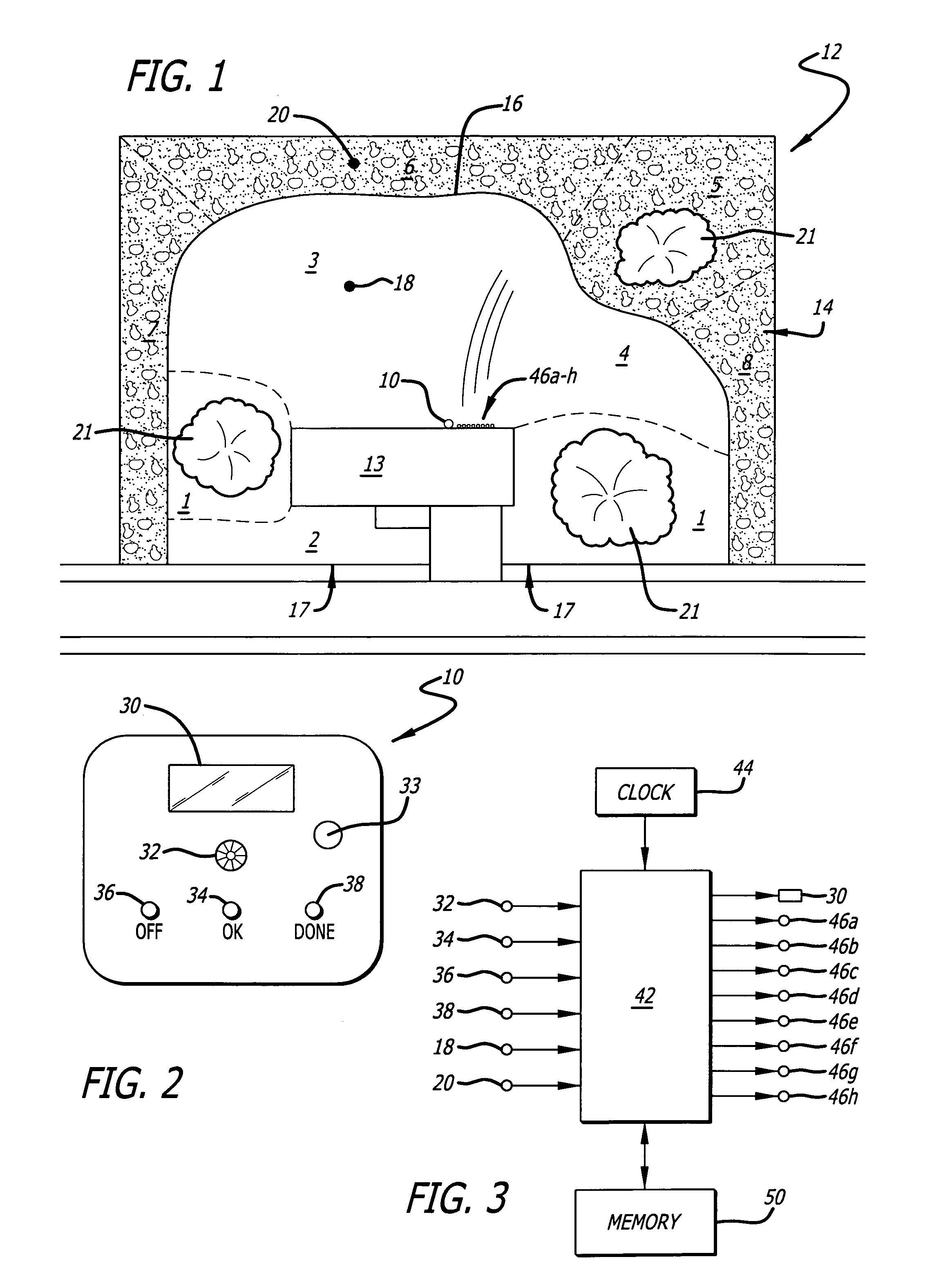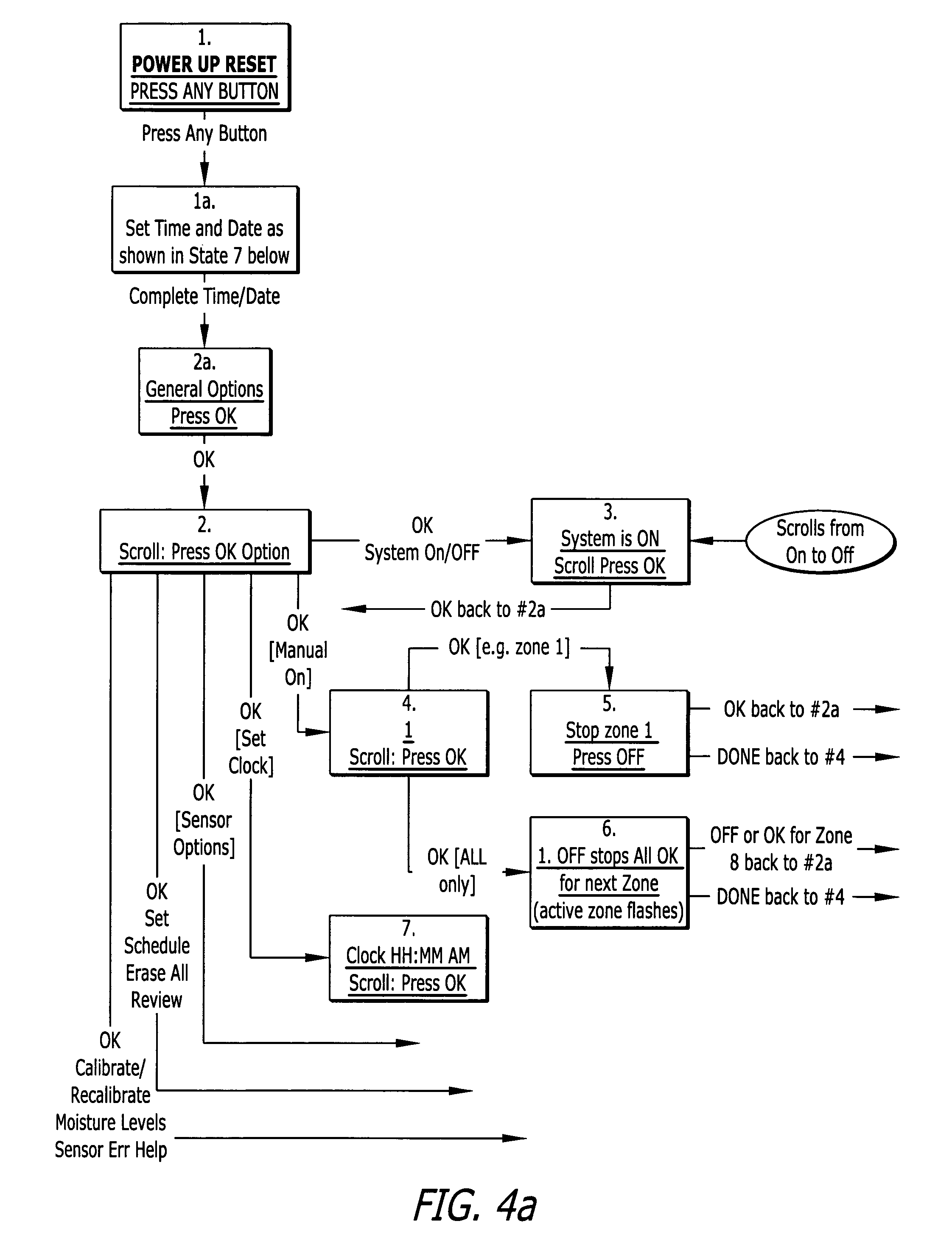Method and apparatus for optimizing soil moisture
a technology of soil moisture and optimizing method, which is applied in the direction of electric controllers, ignition automatic control, instruments, etc., can solve the problems of inability to adapt the controller, inability to continually adjust the irrigation system to maintain an ideal soil level, and impractical reprogramming amount, etc., to achieve the effect of not prohibiting equipment and labor costs
- Summary
- Abstract
- Description
- Claims
- Application Information
AI Technical Summary
Benefits of technology
Problems solved by technology
Method used
Image
Examples
example 1
c) EXAMPLE 1
[0418]With the understanding that the MC / WN tables set out below are merely examples of a currently preferred embodiment and are subject to change in accordance with the needs of specific hardware and a specific installation, the MC / WN table of a typical SIC 10 could be organized to cover sensor voltages ranging from the target value (a value slightly higher than Sfc, e.g. 0.125 V higher) to a value 2 V above Sfc (this is empirically the largest swing between excessive wetness and excessive dryness expected for most soil types for a representative embodiment of a sensor). In the preferred embodiment, the MC / WN tables partition this voltage range into fifteen equal 0.125 V segments (2 V / 16=0.125 V). It will be understood that the number of segments could be different, but in the preferred embodiment, fifteen were found to give sufficient resolution. Suppose now that the target sensor value St, is 1+0.125=1.125 V in accordance with equation (1) above. Then the initial runt...
example 2
d) EXAMPLE 2
[0433]Now consider a typical normal watering cycle using the above-described proportional algorithm. Assume that a pre-irrigation sensor reading is taken and found to be 2.15 volts. Using the above table, the master zone of the affected group would again be scheduled to run for 9 minutes. Since this is more than 2 minutes, the irrigation cycle would occur. Following completion of the irrigation cycle (after a sufficient delay to allow the water to infiltrate and equilibrate), the post-irrigation sensor reading is taken. As a matter of example, this reading will again be assumed to be 1.55 volts. This post-irrigation sensor reading is now compared to St to determine if the 9-minute irrigation was effective in bringing the soil to the desired level of moisture content. In this case, the post-irrigation sensor reading is found to be greater than St by more than the modification threshold value. This indicates that there needs to be a change to the MC / WN table entry used to ...
example 3
e) EXAMPLE 3
[0442]This example illustrates the use of the convergent modification algorithm described in Section E.4)b)iii) above. In this example, the following pre-irrigation Table VII is the same as Table I of Example 1:
[0443]
TABLE VIISensor reading rangeRuntimeEntry #(volts)(minutes)142.875–2.99915132.750–2.87414122.625–2.74913112.500–2.62412102.375–2.4991192.250–2.3741082.125–2.249972.000–2.124861.875–1.999751.750–1.874641.625–1.749531.500–1.624421.375–1.499311.250–1.374201.125–1.2491
[0444]Assuming a pre-irrigation sensor reading of 2.6 V, the SIC 10 will irrigate for 12 minutes (typically in a series of three-minute increments). A post-irrigation sensor reading is then taken as previously described herein and found to be 1.6 V. This sensor reading corresponds to a four-minute runtime in Table VII. In accordance with the convergent modification algorithm, that four-minute runtime is added to the 12-minute runtime in Table VII, and the adjacent runtimes are modified as described...
PUM
 Login to View More
Login to View More Abstract
Description
Claims
Application Information
 Login to View More
Login to View More - R&D
- Intellectual Property
- Life Sciences
- Materials
- Tech Scout
- Unparalleled Data Quality
- Higher Quality Content
- 60% Fewer Hallucinations
Browse by: Latest US Patents, China's latest patents, Technical Efficacy Thesaurus, Application Domain, Technology Topic, Popular Technical Reports.
© 2025 PatSnap. All rights reserved.Legal|Privacy policy|Modern Slavery Act Transparency Statement|Sitemap|About US| Contact US: help@patsnap.com



